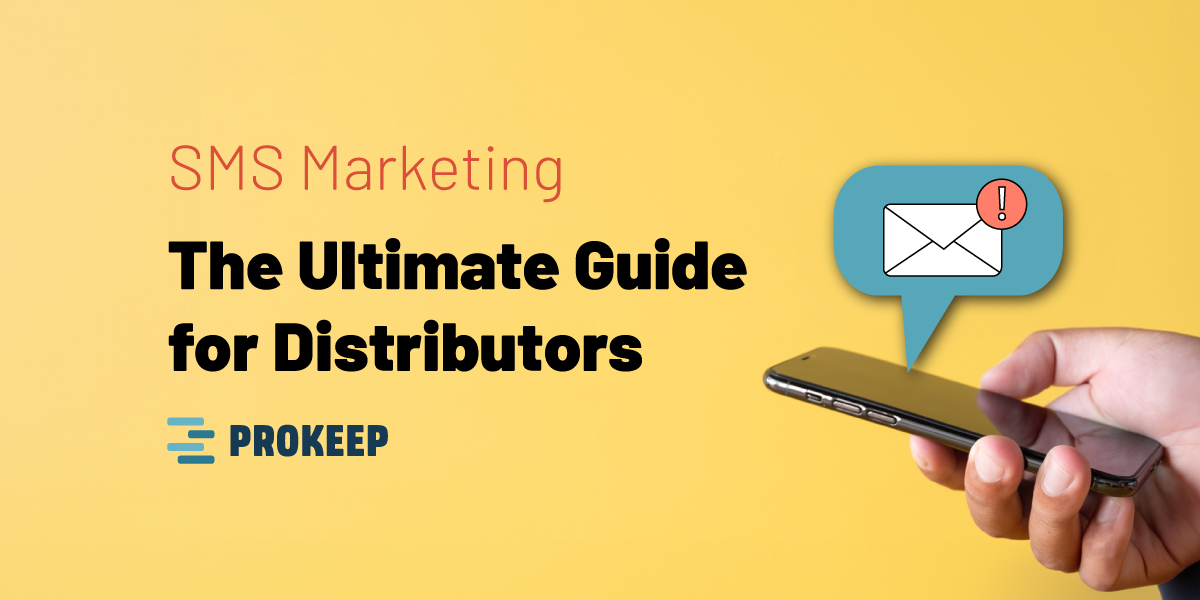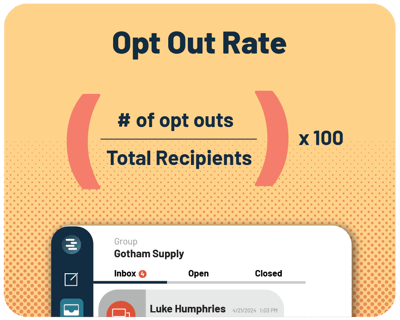
Distributor’s Ultimate Guide to SMS Marketing

In the fast-paced and evolving world of distribution, every second counts. Your customers want instant communication about their orders, deals, and information that helps them get more work done faster. That's why SMS Marketing is becoming the leading source of outbound revenue creation and customer experience improvement among leading distributors.
Picture this: instant messages that hit your customers' phones with deals, updates, and must-know info, all while adding that personal touch that keeps them coming back for more.
SMS Marketing isn't just a nice-to-have; it's a must-have. It's your secret weapon for grabbing attention, driving sales, and building those rock-solid customer relationships that make your business thrive. So, if you're ready to level up and boost your revenue game, it's time to dive into the world of SMS Marketing. Trust us, your competitors are already on board, and you don't want to miss out on adding this simple swiss army knife to your sales and marketing toolbelt!
But what is SMS Marketing exactly and how can distributors use it to drive revenue?

What is SMS Marketing?
SMS Marketing enables you to send text messages—about promotions, events, last-minute deliveries, and other things—to large groups of customers right to their mobile devices.
For busy contractors who don’t have time to stop what they’re doing, make a phone call, and wait 15 minutes on hold, this is a seamless way to be reminded of a product they need or a promotion they’re interested in. For you, it’s an easy way to keep your business top of mind, upsell, and, engage.
Why Use SMS Marketing?
SMS Marketing allows you to reach your audience quickly, cost-effectively, and with a high level of engagement.
Key Benefits of SMS Marketing:
- Broader Reach: SMS broadens your reach beyond those currently standing in your branch. Within seconds, you can connect with anyone in your database quickly.
- Convenience: Composing and sending a brief text message only takes your team a few minutes, whereas writing an email, sending a marketing mailer, or designing a large marketing campaign will be a heavier, more intentional lift.
- Higher Open Rates: Unlike email or phone calls, text messages have high open rates and are typically read immediately. This makes them ideal for time-sensitive announcements, promotions, or updates.
- Opportunities for Personalization: You’re able to tailor your messaging to specific segments of your audience and use key identifiers like first name and past purchases.
- Allows You to Re-engage: Without SMS Marketing, you're reliant on your customers' sporadic visits to the branch. But by sending them a message straight to their cell phones, you take initiative, keep the business top-of-mind, and entice them to buy.
- Cost-Effective: Text messaging is more cost-effective than traditional forms of advertising, like print or television. You can reach a large audience with minimal investment per message sent.
And these are just some of the benefits SMS Marketing offers you.
1:1 Business Texting vs. SMS Marketing
Text enabling your business phoneline is a powerful strategy for serving customers in a fraction of the time. Thousands of distributors are seeing a surge in revenue through Prokeep’s SMS solution, as it empowers them to say goodbye to long hold times, missed calls, and a frustrating customer experience.
Text messaging presents many opportunities when used as a business tool. It allows you to proactively reach out to customers, checking on a purchase or prompting them to buy. By connecting with their ERP, distributors use SMS to send automated alerts to customers on order status, delivery notifications, and more.
Some examples of 1:1 messages include:
- A response to a customer order via text
- Technical support from a picture
- An order status update
 When it comes to serving one customer, sending a one-to-one text message rather than picking up the phone, saves you a lot of time. But if you have an announcement or promotion you need to get out fast — it is time consuming and, frankly, near impossible to manually text all your customers in a short amount of time.
When it comes to serving one customer, sending a one-to-one text message rather than picking up the phone, saves you a lot of time. But if you have an announcement or promotion you need to get out fast — it is time consuming and, frankly, near impossible to manually text all your customers in a short amount of time.
That’s where SMS marketing comes into play.

Thanks to its unparalleled reach, immediacy, and effectiveness, SMS marketing has become a cornerstone strategy for distributors —with a 98% average open rate compared to email’s 20%. In an era where contractors are swamped with marketing messages across channels—many of which don’t allow them to engage with you—SMS stands out for its ability to directly connect with customers and deliver targeted messages straight to their pockets.
Prokeep—a conversation hub built for distributors—is propelling thousands of distributors to greater success with its Broadcast Text Messaging feature, designed for easy SMS marketing.
Distributors using Prokeep’s Broadcast Text Messaging feature have:
- Taken more ownership of their revenue
- Engaged with and upsold their customers
- Nurtured customer relationships
- And more!
SMS Marketing Concerns: Expectations vs Reality
What if customers get annoyed? What regulations do you need to follow? The idea can be overwhelming to distributors looking to get started, but in reality, these concerns are easy to mitigate.

While these are very real concerns, they shouldn’t prevent you from taking advantage of the value SMS Marketing offers. With careful consideration of your process, you can easily mitigate risks and get the most out of your SMS marketing strategy.
Different Types of SMS Marketing Campaigns
SMS Marketing serves many purposes and is a diverse tool for communicating with and marketing to customers. You can categorize different formats of Broadcast Text Messages by their intent and their content. Some common types include:
- Promotional Messages: These are intended to promote products or services. They often include discounts, special offers, or announcements about upcoming sales or promotions.
- Event Messages: These alert customers of upcoming events and include key details like time, location, and the purpose of the event.
- Educational Messages: These messages provide useful information to customers, such as a tech tip or industry-related update. This is an easy way for you to provide value to customers and connect with them beyond enticing them to buy.
- Last Chance for Purchase Reminders: These alerts prompt customers of their last chance to make a purchase before, for example, a delivery truck goes out. These are different than one-off delivery notifications on orders.
- Customer Sentiment: These are surveys looking to gauge customer feelings or opinions, towards a product, service, brand, or experience. You can then use these insights to inform your strategy.
Types of Promotional Messages
Sending promotions is one of the most valuable things you can do with Broadcast Text Messages. There are several types of promotional messages you use to prompt customers to buy, some examples include:
- A discount for opting in to receive texts
- A flash sale on a brand or line of products
- A holiday discount
- A discount on new inventory
- A discount on old inventory
- A discount for shopping online
- Last chance to receive a discount before the promotion ends
- A discount for items from one particular industry: like 20% off all HVAC equipment
- A discount for all workers within one industry: all HVAC technicians get 20% off

Types of Event Messages
SMS Marketing is a great tool for spreading the word about your upcoming events. Like the various promotions you can run, there are tons of ways to tailor your Broadcast Texts around events. Some examples include:
- A discount for registering
- Upcoming counter day
- Upcoming Lunch & Learn
- Educational webinar invites
- VIP discounts and exclusive offers
- A last-minute event invite
- Upcoming event reminders
- Event countdowns
- Updates and announcements
- A post-event thank you
- Feedback requests following an event
- A link to the calendar for future events
Types of Educational Messages
Educational messages are a great way to diversify content, provide value, and engage with customers beyond simply sending promotions. Some great examples of educational messages include:
- A Tech Tip Tuesday
- A weekly fun fact
- Supply chain best practices
- Industry regulation updates
- Industry tips and tricks
- Seasonal trends and market updates
- New product launch announcements
- Product features and benefits
- Cost-saving strategies

Types of Last Chance for Purchase Reminders
Whether that’s a delivery truck going out soon or you’ve got a low inventory position on an item, you can send out a Broadcast Text Message to alert customers that time is running out to get their orders in. Examples include:
- An alert that you’re visiting an area tomorrow, get in orders by today.
- An alert for upcoming order cut-off
- Last chance to get an order on tomorrow’s delivery truck
- Last chance to get a discount on an ending promotion
- Last chance to stop by before the store closes
- Last chance to get an item that’s running low
Types of Customer Sentiment Messages
Customer sentiment messages solicit feedback and insights directly from contractors, helping you understand them, their experience, and how you can make improvements. An SMS Sentiment Campaign is a powerful way to gather lots of customer sentiment information in a short amount of time. Examples of customer sentiment messages include:
- Customer Satisfaction Surveys
- Product Feedback Surveys
- Net Promoter Score (NPS) Surveys
- Market Research Surveys
- Preference Polls
- Opinion Polls
- Customer Demographic Surveys
- Post-Purchase Surveys
Being intentional behind the kind of broadcast text message you send ensures that your messages are valuable and exactly what your customers need.

Using different types of broadcast text messages is a must. If you’re only sending promotions, your customers will eventually lose interest and may even unsubscribe. By using a content calendar, developing a strong cadence, and incorporating a healthy mix of promotions, educational messages, customer sentiment, and more, you’ll eliminate message fatigue and always be providing value.
And if you want a quick and easy way to make use of all different types of Broadcast Text Messages, get our downloadable templates, that way, all you need to do is fill in specifics and send the messages on their way!
Creating your SMS Marketing Strategy in 9 Steps
Here are our top best practices for driving value, keeping your customers engaged, and optimizing your use of SMS marketing. Get started fast, download the Prokeep SMS Marketing Plan Template.
|
List of Best Practices: Table of Contents |
Best Practice 1: Use a Content Calendar
A content calendar is the best place to start. With a content calendar, you can plan what you’ll send out. This way, Broadcast Text Messages will be easy to fit into your workflow, and you’ll be able to make more strategic decisions.
You’ll also be able to avoid overloading customers with messages or scrambling to get them out last minute.
A content calendar offers you:
- Consistency: Keep a consistent schedule of outbound messages.
- Planning: See how messages align with seasonal events, available inventory, and more.
- Content variety: Easily diversify your content when you build your cadence.
- Audience segmentation: Ensure you’re hitting each segment throughout your cadence.
- Time-saving: No last-minute scrambling to get a message out.

Want a free template to get started? Download our SMS Marketing Content Calendar below.
Best Practice 2: Opting in Your Customers
What is an opt-in and why is it important (i.e. to send a BTM, you must first create a list of customers who have indicated that they would like to receive your promos, event info, etc. via text message.) How do you create this list?
Your journey starts with your opt-in. Making your opt-in process easy, offering multiple opt-in channels, and clearly communicating the benefits of subscribing, maximizes your chances of building a robust subscriber list. Examples of opt-in channels include:
- Your website
- Your checkout counter
- Social media
- Email campaigns
- An in-store sign-up
- Events and promotions
and more! Check out our opt-in templates for easy messaging you can use to prompt customers to sign up!

If you’re worried about following SMS compliance, a double opt-in is a great way to make sure customers know what they’re getting into. After a customer has signed up to receive texts, automatically prompt them to confirm their opt-in by responding to the welcome message.
|
Why Use a Double Opt-in
|

Best Practice 3: Start with a Welcome Series
A strong welcome series sets the tone for your Broadcast Texts. It’s your chance to introduce yourself, show the value you’ll be providing, and meet SMS compliance requirements. Once someone Opts in to your SMS Marketing list, you should immediately send them a welcome message so they can save your number and see how it works while it's on their mind.
With a welcome message, you’re able to:
- Give a good first impression.
- Enable a double opt-in.
- Personalize the message with their first name.
- Collect data from subscribers.
- Boost engagement with an offer.

Best Practice 4: Crafting the Right Message
By crafting the right message length, you’ll ensure that your messages are valuable and well-received. Consider the type of message you’re sending, and consider using images when you can. An upcoming event with many key details might require a little more text than, say, a flash sale on old inventory.

Some pro tips on crafting the right message include:
- Be Concise: SMS messages have a character limit, so keep your message concise and to the point.
- Offer Value: Provide value to the recipient in every message, whether it's a special offer, exclusive discount, useful information, or relevant update.
- Personalize When Possible: Personalize your messages to make them more relevant to the customer. Use their name, previous purchase history, or other relevant information to tailor the message.
- Use a Clear Call-to-Action (CTA): Include a clear CTA that conveys what you want customers to do next, whether it's making a purchase, visiting your website, or replying to the message.
- Create Urgency: Use language that creates a sense of urgency to prompt immediate action, such as: “Limited-time offers, flash sales, and ends today!”
- Use Images: There’s nothing more eye-catching than using an image. Information can get lost in text, so when you can, consider using images to break up the copy.
- Mind the Timing: Be mindful of the timing when sending Broadcast Text Messages. Avoid sending messages late at night or early in the morning to respect recipients' time.
- Test and Iterate: Continuously test different message formats, CTAs, and timing to determine what resonates best with your audience.
- Comply with Regulations: Make sure your SMS messages comply with regulations, like the Telephone Consumer Protection Act (TCPA) in the United States or the General Data Protection Regulation (GDPR) in the European Union.
- Maintain Brand Consistency: Keep your messaging consistent with your brand voice, tone, and values. This helps build brand recognition and reinforces your brand identity with recipients.
Want a place to start?
Download our SMS marketing message templates built for distributors

Best Practice 5: Find the Right Cadence
Are your customers hungry for deals and always ready to talk to you? Or do they prefer to check their phone less frequently?
Finding the right cadence is key to providing value and ensuring you’re not bothering your customers, but it nonetheless takes a little trial and error.
Here are key steps we recommend to find the right cadence:
|
Finding the Right Cadence:
|
Best Practice 6: Segment Your Audience
That leads us to the next best practice - segmenting your audience. A segmented list based on demographics, industry, or other identifiers helps you tailor your messaging and make more strategic decisions.
Factors you can use to build segments include:
- Demographics
- Purchase history
- Engagement level
- Interests and Preferences
- Customer lifecycle
You can then use these segments to personalize your messaging to each — showing subscribers that you understand their needs and interests, building loyalty, and driving them to engage.
Here are some top things to personalize in your messaging:
Top Things to Personalize:
|
Pro tip - Build a VIP list: People love feeling exclusive – so make them feel special and offer VIP-only discounts, early access to sales, and other benefits. This builds loyalty and segments a group that will be interested in receiving more messages from you.
Best Practice 7: Use A/B Testing
Once you’ve segmented your subscribers, A/B testing lets you test different methods and discover what drives the most engagement.
A/B Testing offers you many benefits like:
- More data for more informed decision-making
- Reduced risk when testing new strategies
- Insight into user behaviors
- Hard proof of any hypothesis you have
- Continuous improvement on your SMS Marketing strategy
Here are some examples of things you can test:
| Message length | Emojis or capitalization |
| Line breaks | Times of the day to send |

Best Practice 8: Use Outbound Messages to Create an Inbound Engine
Sending Broadcast Text Messages is a proactive way of reaching out to customers, but this effort is meritless if it’s not easy to get back in touch.
Where other businesses send out marketing messages without any way to receive a response, Prokeep instantly connects your customers with a counter rep when they respond to a Broadcast Text — that way they’re able to get what they need.

With effective two-way communication, your Broadcast Text Messages will be more than just effective SMS marketing; they will be a robust inbound engine.
An inbound engine attracts qualified leads through valuable content and experiences, engages with them through the channels you have in place, and converts them into loyal customers. With effective SMS marketing, you’ll be drawing customers in rather than interrupting their day, and when they’re enticed by your offer they’ll be instantly connected with you.
Seamless two-way communication empowers you to manage relationships effectively, engage in real-time conversations with customers, address inquiries, resolve issues, and provide personalized assistance in seconds. All of this results in a better customer experience and more inbound sales.
Best Practice 9: Continue Your Outbound Strategy
SMS Marketing proactively reaches your customers on their personal cellphones and alerts them of exciting promotions — but outbound communication doesn’t stop there.
Keep up the momentum and continue to incorporate outbound communications into your workflow. This will drive engagement, keep everyone informed, and make customers feel like they matter.
Other kinds of outbound messages:
- Automated order status updates
- Product post-purchase check-ins
- Requests for feedback
- Upcoming delivery reminders
- Last calls for orders
Measuring SMS Marketing Success
SMS marketing is an ongoing journey, and optimizing your use of SMS Campaigns takes some trial and error. That’s why it’s key to have a means of measuring your success so you can make informed decisions and adjust your strategy accordingly.
Here are our top tips for measuring success as you go.
Setting KPIs
Setting Key Performance Indicators (KPIs) around SMS Marketing helps you measure the effectiveness of your campaigns and track progress.

Want an easy tool to track SMS Marketing success to help visualize ROI?
Download our SMS marketing ROI dashboard built for distributors

Use UTM Parameters
UTM parameters, short for Urchin Tracking Module parameters, are tags added to the end of a URL to track the effectiveness of online marketing campaigns. They allow you to gain insights into the metrics listed above and monitor the success of your campaigns.
UTMs are built of key-value pairs appended to a URL using a question mark (?) and ampersands (&) to separate them. The five standard UTM parameters are:
- utm_source: identifies the source of the traffic, such as a search engine (Google, Bing), social network (Facebook, Twitter), or newsletter.
- utm_medium: specifies the medium through which the traffic was generated, such as email, social, CPC (cost-per-click), or referral.
- utm_campaign: indicates the specific marketing campaign or initiative that the link is associated with. For example, a summer sale campaign or a product launch campaign.
- utm_term: typically used for tracking keywords in paid search campaigns. It identifies the keywords used in the ad or the terms associated with the link.
- utm_content: used to differentiate between different versions of the same ad or link. It can be used to track A/B testing or to identify specific elements within the same campaign.
Watch Your Steady Growth Overtime
Once you’ve set KPIs around your SMS Marketing, monitoring your advancement towards achieving them is key.
|
Here's a step-by-step guide on how to track KPIs effectively:
|
While you’re tracking the success of your SMS Marketing campaign, each type of Broadcast Text message has metrics you can set KPIs on and pay close attention to understand your success and ROI.
|
Metrics for Tracking Your Promotional Messages:
|
Metrics for Tracking Your Route Reminder Messages:
|
Metrics for Tracking Your Educational Messages:
|
Metrics for Tracking Your Event Marketing Messages:
|
Understand and Calculate Your SMS Opt-Out Rate

Your opt-out rate is the percentage of your SMS subscribers who choose to stop receiving messages from you.
It’s completely normal for consumers to opt out of your SMS program for a variety of reasons. And remember that opt-outs don’t mean they’re gone and never coming back. They can easily choose to resubscribe whenever they’re ready.
You can calculate and track your SMS unsubscribe rate. This helps you understand how specific messages are being received by your customers and informs your strategy in the future. Simply divide the number of opt-outs by the total number of message recipients and then multiply that number by 100.
With the best practices outlined above, you can make SMS Marketing a pleasant experience and actively work to decrease your opt-out rate.
SMS Compliance and What You Need to Know
Like any channel, SMS is regulated and has specific requirements. For example, In many cases, it’s illegal to send text messages to your customers without their consent.
Laws you need to abide by in the United States include:
- The Telephone Consumer Protection Act (TCPA): a federal law passed in 1991 that mandates you to receive written consent from mobile subscribers before sending them marketing text messages.
- CTIA Guidelines: a trade association that outlines the US wireless communications industry and provides requirements.
- The Americans With Disabilities Act (ADA): a federal law that sets standards for making public accommodations accessible to people with disabilities.
SMS compliance may seem overwhelming, but it’s not rocket science! Here are the must-knows:

Check out the SMS Compliance guide here for more information.
The Best SMS Marketing Software for Distributors
SMS Marketing is a powerful tool for re-engaging customers and driving profitability, and as a leading communication software in distribution, Prokeep is powering business owners like you to do just that.
By sending text-only specials with Prokeep’s Broadcast Text Messaging Feature, team members at Truckworx saw a drastic increase in sales.
With Prokeep’s SMS Marketing Feature, distributors are seeing benefits like:
- Increased e-commerce sales
- Streamlined deliveries
- Better marketing communication
- Increased operational efficiency
- & More!
Are you looking for a communication tool that will kickstart your SMS marketing journey? Book a demo and see how Prokeep can help!








